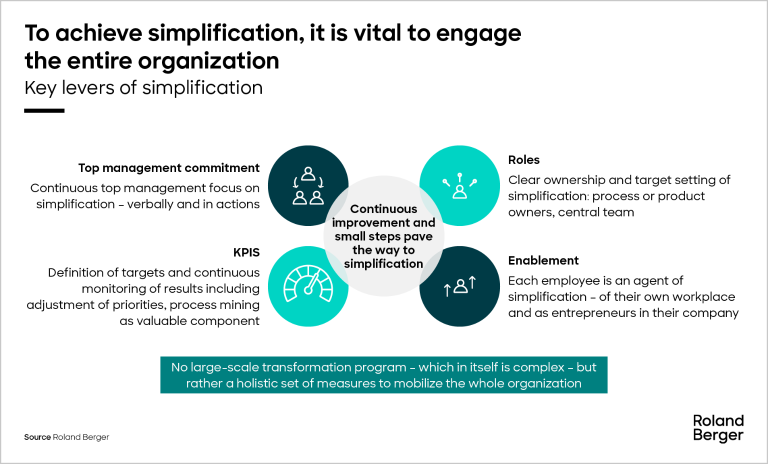New Roland Berger and Solaris report on how to drive revenue growth.


The simplification imperative: why banks must act now
By Viktoria Danzer and Dominik Löber
Leveraging current profits to streamline operations and secure future success in an evolving financial landscape
Banks were thriving in 2023, with European players seeing their highest return on equity since 2007. But as 2024 unfolds, signs of economic slowdown loom. The recent shift from near-zero interest rates to a more conventional environment has boosted profitability, but it's merely papering over long-standing issues. Now is the critical moment for banks to address their backlog of IT investments, counter pressure from nimble competitors, and untangle the web of complexity that threatens their future success.

"The recent interest rate movements have provided banks with some breathing room. However, if banks want to achieve sustainable success, they must reduce operational complexity. "
Why the urgency?
While 2023 brought record revenues and profitability to European banks, with the European Central Bank (ECB) reporting an average 7% return on equity, 2024 is already showing signs of weakening. The primary driver behind this recent resurgence was the ECB's shift to a more conventional interest rate environment, allowing banks to widen their net interest margins. However, this financial windfall has merely masked several critical issues that continue to plague the banking sector.
Banks still grapple with outdated IT infrastructure awaiting much-needed investment and face mounting pressure from more agile market participants. Complex processes have accumulated over years of implementing overlapping regulatory requirements, leading to inefficiencies and inflexibility. Product landscapes fail to meet growing demands for personalization, while siloed decision-making and misguided "data-driven" approaches hinder progress. Furthermore, entrenched hierarchical structures perpetuate these inefficiencies, making it difficult for banks to adapt to rapidly changing market conditions.
The recent interest rate movements have provided banks with a temporary reprieve, but this may be their last chance to address decades of accumulated complexity. While artificial intelligence (AI) offers potential solutions to many of these challenges, complex organizations like banks often struggle to effectively implement new technologies. As the window of opportunity narrows, banks must act decisively to modernize their operations, streamline processes, and embrace innovation to remain competitive in an increasingly dynamic financial landscape.
"Banks have a transformative opportunity: simplification. With clear goals and motivation, forward-thinking institutions can streamline operations, boost efficiency, and gain a competitive edge in the evolving financial landscape. "
The benefits of simplification
Simplification offers banks numerous benefits across their operations, impacting key performance indicators and organizational culture.
Revenue and Costs: Studies show that simplicity and transparency lead to higher customer satisfaction and improved sales performance. The European Banking Authority found that banks focusing on transparent, customer-friendly practices saw a 12% higher customer retention rate. On the cost side, fewer reports, documents, products, and processes inevitably lead to lower operational expenses, with some banks reducing costs by up to 20% through simplification.
Customer Experience: Simplicity enhances the banking experience. Fintechs like Revolut and Trade Republic have capitalized on this "fun" factor, rapidly growing their customer base. Traditional banks that can capture this element could significantly strengthen customer loyalty.
Employee Satisfaction: In an era of intense competition for talent, simplification is crucial for employee engagement and retention. Young professionals are more likely to be drawn to lean, open, and dynamic environments rather than complex, rule-bound organizations where change seems impossible.
Overcoming obstacles to simplification
If the benefits are so clear, why do banks struggle to achieve simplification? Three main factors are at play:
- Stickiness: Creating complexity is far easier than eliminating it. Product development teams often prefer creating new offerings rather than pruning existing portfolios, while compliance teams tend to add rules rather than questioning existing ones.
- Moral Hazard: The benefits of simplification are significant but difficult to attribute and slow to materialize. In a short-term focused environment, this presents a challenge for managers driven by quarterly results.
- Fear: Simplification fundamentally changes work processes. Many employees have spent years learning to navigate existing systems and may resist changes that could make their roles obsolete.
The path to simplification
While simplification needs to be a bank-wide effort, it doesn't require a massive, top-down program. Instead, start small and scale up:
- Achieve Tangible Results First: Address well-known, irritating issues through simple decision-making. For example, reducing internal committees by 10% could save up to 5% in management time annually.
- Change the Game: Implement specific, actionable changes rather than producing broad guidelines. Require clear ownership and agendas for meetings, or mandate that for every new document or process created, two existing ones must be eliminated.
- Walk the Talk and Engage Everyone: Top management must embody simplification by changing habits and challenging hierarchical norms. Encourage and recognize employee-led initiatives to streamline processes.
- Measure and Communicate: Create a dashboard to track progress, focusing on available data. Set ambitious targets (30-50% reductions) and communicate successes widely to demonstrate commitment.
- Scale and Systematize: Once initial steps prove successful, tackle bigger challenges like key processes, product landscapes, and IT infrastructure. Consider implementing incentive schemes to embed simplification into the organization's culture.
This step-by-step approach reduces the risk of failure and allows for learning and adjustment before scaling—an essential strategy when addressing complex challenges.
The time for banks to act is now. By leveraging current favorable conditions, they can prepare for future challenges and the disruptive effect of new technologies. While the benefits of simplification are immense, so are the obstacles. A tailored, incremental approach is crucial for success. Like training for a marathon, every small step counts towards the ultimate goal of a leaner, more agile banking institution ready to thrive in an evolving financial landscape.







